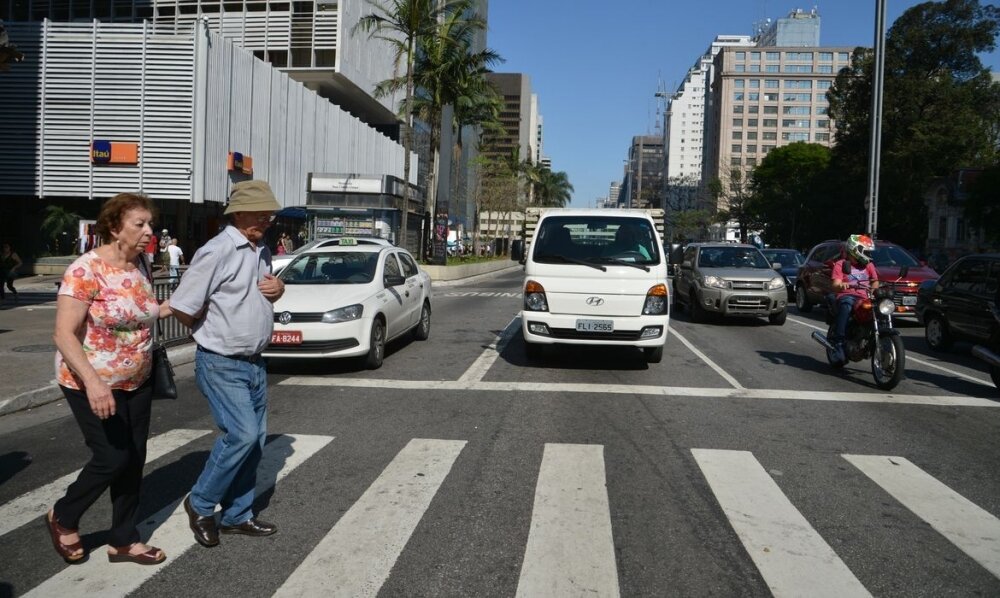#Older people with abdominal fat and weak muscles are more likely to develop mobility problems

“#Older people with abdominal fat and weak muscles are more likely to develop mobility problems”

Weak muscles and abdominal fat are a dangerous combination for older people who have difficulty walking. A study conducted by researchers at the Federal University of São Carlos (UFSCar) in the state of São Paulo, Brazil, in partnership with colleagues at University College London (UCL) in the UK, points to a significant loss of gait speed in older people with these two physical traits.
A slower gait is a natural outcome of the aging process, but mobility problems can result if walking speed falls sharply. Everyday activities such as crossing the street before the traffic lights change become increasingly difficult, and there may be a heightened risk of falling as well as a gradual loss of independence if the condition worsens.
“Our comparative analysis showed loss of gait speed occurring mainly when abdominal fat and weak muscles were associated. Gait speed didn’t decline so sharply in older people who had only abdominal fat or only weak muscles,” said Tiago da Silva Alexandre, a professor at the Department of Gerontology, Center for Biological and Health Sciences, Federal University of São Carlos (CCBS-UFSCar), and last author of a paper on the study published in the journal Age and Ageing.
The study analyzed data for 2,294 individuals aged 60 or more who participated in the English Longitudinal Study of Aging (ELSA). It was supported by FAPESP via a Young Investigator Grant and a Ph.D. scholarship.
The participants were divided into four groups based on their ELSA data for gait speed and muscle weakness (dynapenia): Neither dynapenic nor abdominally obese, abdominally obese only, dynapenic only, and both dynapenic and abdominally obese.
None of the participants had problems with mobility or gait speed when measurement began. Gait speed declined most in those with abdominal obesity and dynapenia in the ensuing eight years of monitoring.
According to Roberta de Oliveira Máximo, a Ph.D. candidate in UFSCar’s Graduate Program in Physiotherapy and first author of the paper, the baseline gait speed for people in this age group without mobility restrictions was defined as 0.8 m/s (or 2.88 km/h). “In the participants with abdominal obesity and muscle weakness, we observed a loss of 0.15 m/s in the eight-year period. At this rate there may come a time when they can’t cross the street in the time allowed by traffic lights,” she said.
Another study published in 2017 and based on data from a different epidemiological survey showed that 97.8% of a sample of older people in the city of São Paulo were unable to walk fast enough to cross the street while the pedestrian signal was green. Called SABE and conducted by the University of São Paulo’s School of Public Health (FSP-USP), the study did not analyze the correlations between abdominal fat, weak muscles and gait speed.
Obesity and inflammation
The UFSCar researchers noted that an accumulation of abdominal fat activates an intense inflammatory cascade, which consumes muscle mass and reduces strength. “Hence the concept of dynapenic abdominal obesity, which we’ve been studying in our research group for several years,” Alexandre told Agência FAPESP. “In previous studies, we found a correlation between these traits, which are very common in the population, and a heightened risk of falls, alterations to the lipid, carbohydrate, glucose and cholesterol metabolism, incapacity, and even death. But this is the first study to associate them with mobility.”
Abdominal obesity was defined as a waist circumference exceeding 102 cm for men and 88 cm for women. Dynapenia was defined as a grip strength below 26 kg for men and 16 kg for women.
Detailing the association between fat accumulation, weak muscles and loss of mobility, Alexandre said that a decrease in subcutaneous fat and an increase in abdominal fat are normal as age increases. “Abdominal fat is more common in men. In women, fat tends to accumulate around the thighs and hips, but more fat also accumulates in the belly after the menopausal hormone drop. That’s when the inflammatory cascade occurs. The buildup of abdominal fat fuels the inflammation, which consumes muscle mass and reduces muscle strength, while also impairing neural control of the muscles. The outcome is a steady loss of strength and accumulation of fat,” he explained.
For the researchers, therefore, health workers should measure abdominal fat and muscle strength in clinics and hospitals to predict loss of gait speed. “Declining gait speed is an important indicator. It suggests mobility problems, a heightened risk of falls and potential incapacity in older people,” Alexandre said. “Our aim in this study was to show the usefulness of this predictor for medical teams. A sizable number of elderly people have weak muscles and accumulated belly fat. Both can be corrected by exercise training and diet.”
Researchers revise indicator of mobility limitation in older adults
Roberta de Oliveira Máximo et al, Dynapenia, abdominal obesity or both: which accelerates the gait speed decline most?, Age and Ageing (2021). DOI: 10.1093/ageing/afab093
Citation:
Older people with abdominal fat and weak muscles are more likely to develop mobility problems (2021, August 31)
retrieved 31 August 2021
from https://medicalxpress.com/news/2021-08-older-people-abdominal-fat-weak.html
This document is subject to copyright. Apart from any fair dealing for the purpose of private study or research, no
part may be reproduced without the written permission. The content is provided for information purposes only.
If you liked the article, do not forget to share it with your friends. Follow us on Google News too, click on the star and choose us from your favorites.
For forums sites go to Forum.BuradaBiliyorum.Com
If you want to read more Like this articles, you can visit our Science category.


